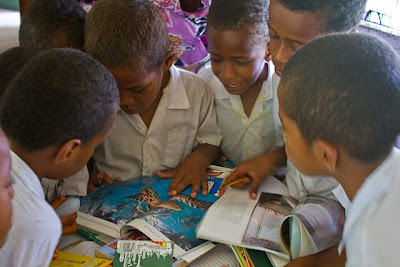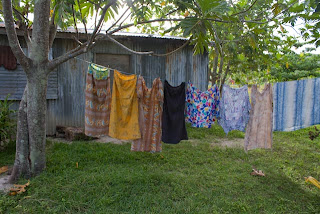There were fewer dugong this morning. Perhaps the chief and his village really did sing them to us. In any event magic seemed to be on our side this morning when I noticed a familiar appearing canoe across the channel. Ev headed over and though my canoe turned out to be a speed boat he found the small village where the chief and his friends lived.
It turned out the chief had been called to a meeting and we could reschedule our dance, or we could have a partial refund. We took the refund, because despite wanting to think the best of these folks they really didn't act in the most honest way. They seemed suitably saddened though when Evan let them know we'd be telling other cruisers about our sketchy experience.
We decided to try to end our time in the Maskelynes on a good note though and with settled weather here (and a weather window to Oz still several days away) we headed to Lutes.
Lutes is perhaps what people imagine of a South Seas village. The thatched homes ring the beach and as we approached a crowd gathered on the beach. Little girls held bouquets of flowers out to us and we were introduced around. Then we were taken to the chief-who asked what we'd like to do in the pretty village. We told him we wanted to meet a Turtle Singer-I wanted to confirm the experience we had in Gaspard.
Tasso is very old, nearly blind and was happy to tell us about singing for turtles. Children and young men gathered around him, the littlest ones draped over him, as he answered our questions: he doesn't know why they sing for turtles they just always have, the song means thank-you for the turtle we won't be eating pig, catching a turtle marks the transition from boy to man, but now, with conservation laws, they have a limited 3-day hunt and feast each year and the village is allowed 12 turtles, other than that they just sing to the turtles for tourists.
We sat with Tasso for a while after he sang the same song chief Jean had sung for us and the 'magic' he described matched our experience exactly. Then the children led us up and down the village paths until everyone had met us.
Now we're on the boat-dugouts stop by to say hello and children are laughing on shore. Soon the stars will come out and all will be blackness except for the cooking fires in the huts on shore.
Maskelyne Islands - Navigation Notes
First off, the currents in the channels and outside the barrier reefs to the S and E of the island groups are quite strong, even in the open ocean. The currents we saw were in the maximum range of 3 knots with obvious upwellings from bottom structures. No big deal between the islands as you just go faster or slower if the current is against you, but offshore from the reefs, if the current is opposing the prevailing SE wind and swell you can get very steep washing machine effect seas.
Coming from Epi Island to the south, we planned to anchor on the S side of Uliveo Island, behind it's reef - but the seas were so chaotic we couldn't see the clear path. So we bailed, quickly entering new waypoints in the GPS in the rough seas, and headed up the East side of the group to enter the channel between Sakoa I. and the big island of Malakula.
We then proceeded to enter Gaspard Bay, avoiding the shoal patch in the middle. We anchored behind the shoal, in about 45' of water, mud bottom, good holding. No swell, though the strong SE wind still penetrated partly into the bay.
Important note: our "Tusker Cruising Guide to Vanuatu" electronic guidebook had very strangely mirror imaged the aerial photo and chartlet for Gaspard Bay along the N/S axis. The chart is also on its side so north is on the left. I couldn't figure it out when looking at the bay until I looked at the compass rose. So the shoal in the middle of the bay, which is somewhat offset to one side, was on the other side of bay compared to the aerial map/chart! It was also overcast which made it hard to see the shoal very well.
Our next destination was the village of Lutes, on the SW corner of Uliveo. The Tusker GPS waypoints and aerial photos were very helpful as you pass through two tight reef spots just before the village. The anchorage is a mud bottom, about 50' deep. We sat sideways to the small amount of refracted swell that comes through but it wasn't bothersome. If there was a big (say >2m SE) swell running it might get more uncomfortable. In a S swell it might not be pleasant at all.
Try to travel at low tide - it's much easier to see all the reefs. Really be cautious in overcast conditions. The island's fringing reefs stick out a long way sometimes. Staying mid channel between the islands as you follow all the Tusker GPS waypoints will be the safest way to travel during overcast. During good light we could easily see the reefs and cut corners on the GPS routes.
----------
radio email processed by SailMail
for information see: http://www.sailmail.com















































